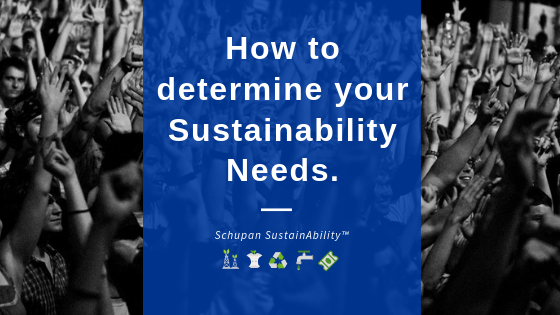How to determine your sustainability needs.
You and your team decide to implement a sustainability program at your upcoming event. But where do you start? The road to being environmentally friendly can be cumbersome and confusing. We hope this guide will help you and your team to know where to start.
Step 1: Determine what you can recycle, not necessarily what you want to recycle.
Take a look at the trash you are producing.
- What products are vendors bringing in and discarding?
- Are your attendees consuming their beverages in the bottle/can, plastic cups, or Styrofoam cups?
- Are you discarding a lot of cardboard boxes from volunteer t-shirts, supplies, programs/brochures?
- Are you throwing away a lot of signage after each event?
Sometimes, we can get caught up in the idea of recycling a certain item or bringing in a certain sustainable feature to the event, even though that feature won’t have the biggest greening impact or isn’t the easiest to implement.
On average, there are four primary materials events produce. We recommend you start Step 1 by looking into these four materials:
- Cardboard. Vendors often times discard cardboard with their food packaging products and the event staff discards cardboard from their prep materials (such as volunteer t-shirt boxes, brochures, etc). Cardboard will almost always be produced back of house.
- Beverage containers. How are your attendees consuming drinks at the event? Are you serving bottles/cans to your attendees or pouring drinks from behind the bar where empty glass bottles of wine, liquor, or beer will be located?
- Food waste. The majority of food waste will be produced by your food vendors during food prep and end of the event with unsold food items. Collecting food waste can be challenging. We will be posting about food waste collection in the coming weeks.
- Paper and Signage. Events produce marketing materials in brochures, programs, posters and nearly every event has an “event office” of some sort. Do you have a paper recycling bin in your event office for discarded paper? What happens to your leftover event brochures, posters, and programs? All that signage you create for directions and booths…what happens to it all?
Step 2: Determine how you are going to collect the recyclables, transfer them off-site, and location to deliver the material.
The materials you choose to collect will determine which type of recycling bin is best suited for your needs. The science behind the psychology of recycling bins and signage has been studied across the world. In a later post, we will explore that psychology more. But until then, use this quick guide for easy reference, based off our experience.
| Type of Bin | Commodities
best collected |
Pros | Cons |
| Cardboard Event Box
Different lids can be purchased depending on vendor (example: a lid with a circle hole for cans or a square) |
Can be utilized for all commodities | Cost effective
Wide availability Can collect multiple commodities based on needs and wants |
Not suitable for high winds or rain
Liquid from bottles and cans can cause the cardboard bottom to weaken if bag is perforated Can lead to high contamination rate if specific lids are not utilized |
| There are two standard types of cardboard event boxes: waxed and un-waxed. Waxed cardboard boxes are NOT RECYCLABLE, but can withstand rain better than regular cardboard boxes | |||
| Beverage container specific bins
|
Plastic bottles, aluminum cans, cups | Higher collection rates and lower contamination rates
Bins are reusable |
Price can be become a factor depending on design
Purchased bins will need to be stored between uses, or a vendor with bin rental options would have to be located |
| Single stream recycling bins
|
Can be utilized for all commodities | Allows creative and innovative artwork |
As important as it is to collect the recyclables, transporting them off-site to a recycling center is the hardest logistical part of any sustainability program. As you determine which commodities you want to recycle, contact your local event sustainability partners, recycling centers or city or county programs and be sure to ask these three questions:
- What commodities do you accept? Determine what material they can actually accept within their facility. Not all recycling centers, programs, or event sustainability partners have the capability to recycle all commodities.
- How do you accept the commodities? Some recycling facilities cannot accept bags with recyclables inside. Others may have restrictions such as plastic and aluminum have to be separated.
- What is their availability to accept the material from your event? Event clean-up often happens on weekends, in the early hours of the day or late at night. Be sure to check the operating days and hours and confirm with staff before making assumptions on drop off times. Be sure to double check these times with your event operations so there is little disruption with your labor, permitting, or resources.
Lastly, how are you going to transport the commodity to the recycler? The back of a pick-up truck? A trailer? A rented container such as a roll-off from your local waste hauler or city? Things to consider:
- Safety. Safety should ALWAYS come first. Secure your loads before driving if you are transporting material in the open bed of a pick-up truck or within a trailer. If you are transporting glass or food waste, be sure to protect yourself with gloves and proper eyeglasses. After handling any recyclables, ALWAYS wash your hands.
- Weight. If you are collecting glass, a large amount of paper products, or solid food waste, how do you plan on taking care of the heavy lifting?
In the next blog, we will discuss the design of your program.








 Schupan
Schupan
Leave a Reply
Want to join the discussion?Feel free to contribute!